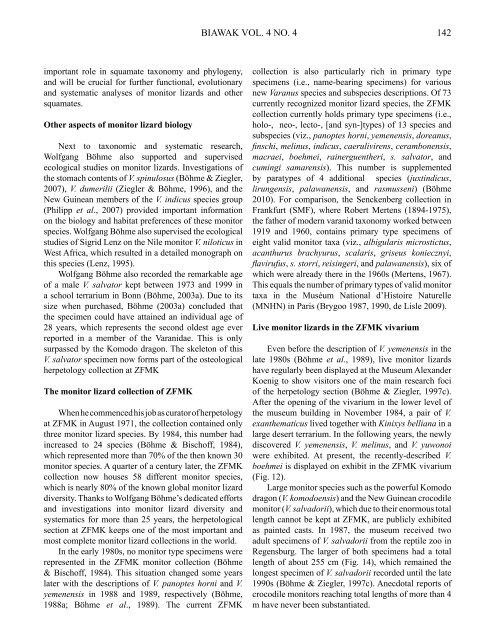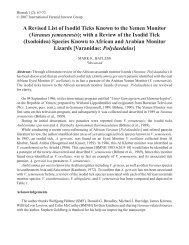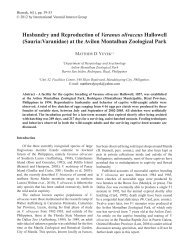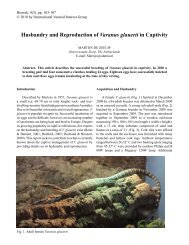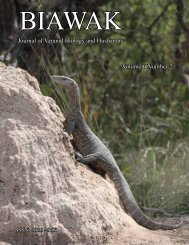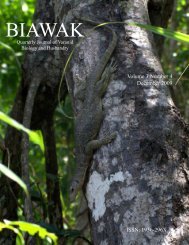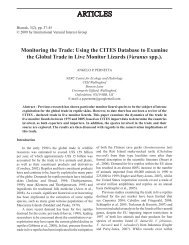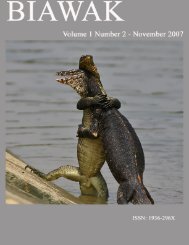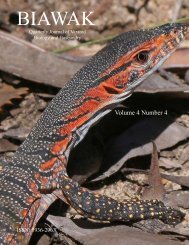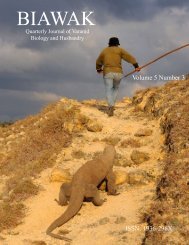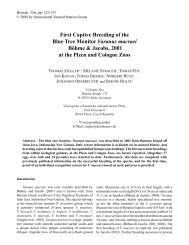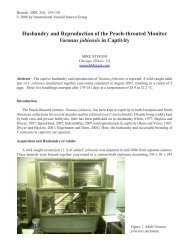BIAWAK - International Varanid Interest Group
BIAWAK - International Varanid Interest Group
BIAWAK - International Varanid Interest Group
- No tags were found...
Create successful ePaper yourself
Turn your PDF publications into a flip-book with our unique Google optimized e-Paper software.
<strong>BIAWAK</strong> VOL. 4 NO. 4<br />
142<br />
important role in squamate taxonomy and phylogeny,<br />
and will be crucial for further functional, evolutionary<br />
and systematic analyses of monitor lizards and other<br />
squamates.<br />
Other aspects of monitor lizard biology<br />
Next to taxonomic and systematic research,<br />
Wolfgang Böhme also supported and supervised<br />
ecological studies on monitor lizards. Investigations of<br />
the stomach contents of V. spinulosus (Böhme & Ziegler,<br />
2007), V. dumerilii (Ziegler & Böhme, 1996), and the<br />
New Guinean members of the V. indicus species group<br />
(Philipp et al., 2007) provided important information<br />
on the biology and habitat preferences of these monitor<br />
species. Wolfgang Böhme also supervised the ecological<br />
studies of Sigrid Lenz on the Nile monitor V. niloticus in<br />
West Africa, which resulted in a detailed monograph on<br />
this species (Lenz, 1995).<br />
Wolfgang Böhme also recorded the remarkable age<br />
of a male V. salvator kept between 1973 and 1999 in<br />
a school terrarium in Bonn (Böhme, 2003a). Due to its<br />
size when purchased, Böhme (2003a) concluded that<br />
the specimen could have attained an individual age of<br />
28 years, which represents the second oldest age ever<br />
reported in a member of the <strong>Varanid</strong>ae. This is only<br />
surpassed by the Komodo dragon. The skeleton of this<br />
V. salvator specimen now forms part of the osteological<br />
herpetology collection at ZFMK<br />
The monitor lizard collection of ZFMK<br />
When he commenced his job as curator of herpetology<br />
at ZFMK in August 1971, the collection contained only<br />
three monitor lizard species. By 1984, this number had<br />
increased to 24 species (Böhme & Bischoff, 1984),<br />
which represented more than 70% of the then known 30<br />
monitor species. A quarter of a century later, the ZFMK<br />
collection now houses 58 different monitor species,<br />
which is nearly 80% of the known global monitor lizard<br />
diversity. Thanks to Wolfgang Böhme’s dedicated efforts<br />
and investigations into monitor lizard diversity and<br />
systematics for more than 25 years, the herpetological<br />
section at ZFMK keeps one of the most important and<br />
most complete monitor lizard collections in the world.<br />
In the early 1980s, no monitor type specimens were<br />
represented in the ZFMK monitor collection (Böhme<br />
& Bischoff, 1984). This situation changed some years<br />
later with the descriptions of V. panoptes horni and V.<br />
yemenensis in 1988 and 1989, respectively (Böhme,<br />
1988a; Böhme et al., 1989). The current ZFMK<br />
collection is also particularly rich in primary type<br />
specimens (i.e., name-bearing specimens) for various<br />
new Varanus species and subspecies descriptions. Of 73<br />
currently recognized monitor lizard species, the ZFMK<br />
collection currently holds primary type specimens (i.e.,<br />
holo-, neo-, lecto-, [and syn-]types) of 13 species and<br />
subspecies (viz., panoptes horni, yemenensis, doreanus,<br />
finschi, melinus, indicus, caerulivirens, cerambonensis,<br />
macraei, boehmei, rainerguentheri, s. salvator, and<br />
cumingi samarensis). This number is supplemented<br />
by paratypes of 4 additional species (juxtindicus,<br />
lirungensis, palawanensis, and rasmusseni) (Böhme<br />
2010). For comparison, the Senckenberg collection in<br />
Frankfurt (SMF), where Robert Mertens (1894-1975),<br />
the father of modern varanid taxonomy worked between<br />
1919 and 1960, contains primary type specimens of<br />
eight valid monitor taxa (viz., albigularis microstictus,<br />
acanthurus brachyurus, scalaris, griseus koniecznyi,<br />
flavirufus, s. storri, reisingeri, and palawanensis), six of<br />
which were already there in the 1960s (Mertens, 1967).<br />
This equals the number of primary types of valid monitor<br />
taxa in the Muséum National d’Histoire Naturelle<br />
(MNHN) in Paris (Brygoo 1987, 1990, de Lisle 2009).<br />
Live monitor lizards in the ZFMK vivarium<br />
Even before the description of V. yemenensis in the<br />
late 1980s (Böhme et al., 1989), live monitor lizards<br />
have regularly been displayed at the Museum Alexander<br />
Koenig to show visitors one of the main research foci<br />
of the herpetology section (Böhme & Ziegler, 1997c).<br />
After the opening of the vivarium in the lower level of<br />
the museum building in November 1984, a pair of V.<br />
exanthematicus lived together with Kinixys belliana in a<br />
large desert terrarium. In the following years, the newly<br />
discovered V. yemenensis, V. melinus, and V. yuwonoi<br />
were exhibited. At present, the recently-described V.<br />
boehmei is displayed on exhibit in the ZFMK vivarium<br />
(Fig. 12).<br />
Large monitor species such as the powerful Komodo<br />
dragon (V. komodoensis) and the New Guinean crocodile<br />
monitor (V. salvadorii), which due to their enormous total<br />
length cannot be kept at ZFMK, are publicly exhibited<br />
as painted casts. In 1987, the museum received two<br />
adult specimens of V. salvadorii from the reptile zoo in<br />
Regensburg. The larger of both specimens had a total<br />
length of about 255 cm (Fig. 14), which remained the<br />
longest specimen of V. salvadorii recorded until the late<br />
1990s (Böhme & Ziegler, 1997c). Anecdotal reports of<br />
crocodile monitors reaching total lengths of more than 4<br />
m have never been substantiated.


